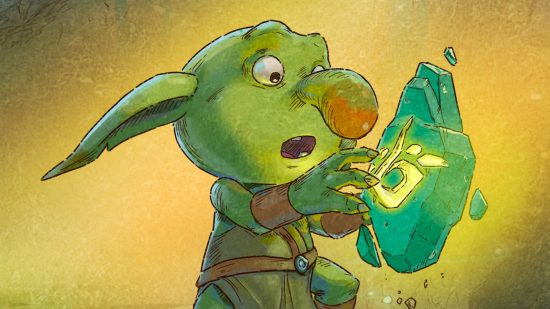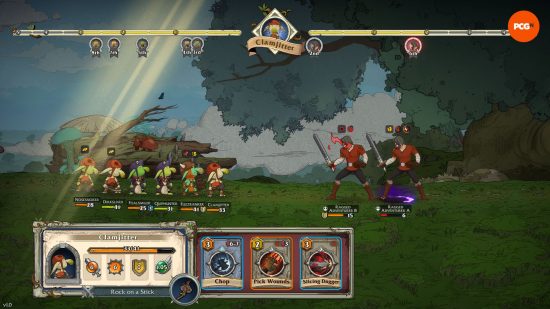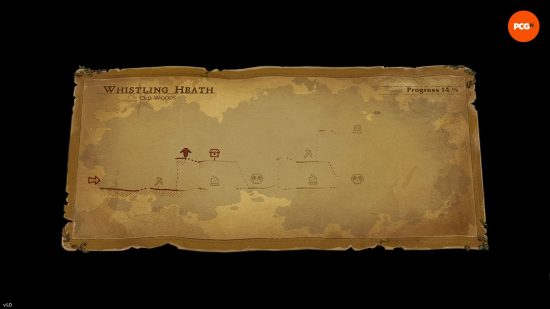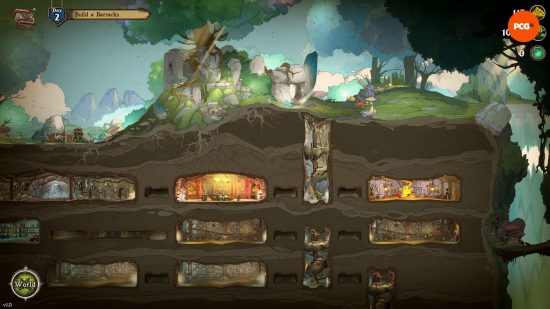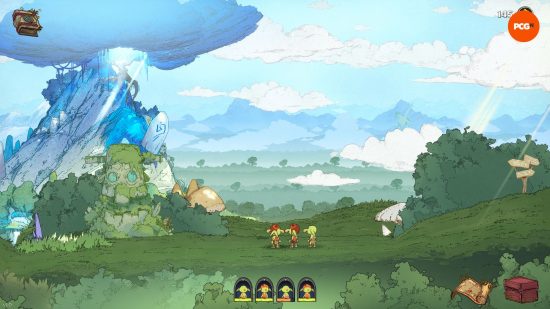We all see the same thing when picturing a goblin: green-skinned, small, ugly, making funny noises, and ripe for adventurers to cut a swathe through their local populous. They’re fantasy fodder at its finest, and not something we think about after a hard day of exploring. When the surviving little goobers crawl home though, what do they get up to, and what would happen if one day they’d had enough? This is the premise of turn-based strategy RPG Goblin Stone, which I’ve been playing ahead of an imminent release on Steam.
When the goblins narrowly escape death at the hands of some adventurers and find the titular Goblin Stone, they set out on a turn-based strategy game adventure fraught with monsters, men, and plenty of RPG mechanics to boot.
There’s XCOM-esque colony management and permadeath, side-scrolling exploration, a gorgeously relaxing art style, position-centric turn-based combat, and a goblin called Moondumper. Goblin Stone has it all, and I’ve been lucky enough to try Orc Chop Games’ new release ahead of the Steam launch, so here’s what I thought, and why this cozy turn-based adventure should be on your radar.

Heading into Goblin Stone, I knew that turn-based combat and I don’t often get along. Without the flashiness of Persona, the myriad creatures of Pokemon, or the high-stakes tension of XCOM, a magnetic field always forms that stops me from enjoying the push and pull of the genre as much as I’d like to. This problem, which is entirely mine, is why I find Goblin Stone’s unique approach to combat so interesting. It’s all about positioning.
Both you and your opponents attack in a line, with the person at the front moving back a certain amount of space depending on the cost of their move. You’re not aiming to do damage as fast as possible, but instead, you’re aiming to control the flow of both you and your opponent’s battle by dictating who’s going to attack next. Offensive, defensive, and ability-based moves all work in tandem to help you control the pace of the fight.
Some moves and status effects are controlled by random chance and percentages, but Goblin Stone isn’t about rolling the dice and hoping for double sixes, it’s about counting cards and stacking the deck in your favor during every turn. To keep the game analogy going, imagine if, instead of just thinking ahead in chess, your moves could also dictate which pieces your opponents could move and where. That’s the core combat loop of Goblin Stone, and it’s really smart.
Your party of six goblins can comprise up to nine different classes, so if you want to lure enemies to attack a defensive goblin, heal up your allies with magic, inflict bleed on any of the opponents to deal damage over time no matter their position, or do any number of other actions, you need to take the right goblin for the job(lin). There are more than enough ways of dictating the flow of battle, and I really enjoy continually pushing the toughest opponents back while I take out their lackeys.
When out on a quest and not in combat, your merry band of goofy goblins is side-scrolling through levels with minor rogue-lite elements. You’ll find forks in the road and need to make decisions about whether you want to go for extra treasure, resources, and tougher enemies, or instead choose the shortest route and beeline for the end because some of your lime lads are worse for wear. Each of these levels isn’t laced with overly complex decisions, but that’s what I liked about them.
Sometimes you just need more resources for your home base, money to buy weapons, or more goblins to recruit, and the branching paths let you pick what matters most to you at any given moment. No one likes it when RPGs give you items you don’t need after victorious battles, so Goblin Stone does away with that by letting you choose what matters to you, at least in the confines of the procedurally generated level routes.
Once you’ve trekked across a level, you’ll return to your goblin colony, where XCOM and management sim fans will see an all too familiar sight. You’ve got an entire underground civilization to build, manage, and make use of. You’ll be digging out space for rooms, outfitting your goblin party, recruiting new members, breeding goblins, and making the macro decisions you’ve come to expect in management games.
While the very early hours of Goblin Stone can feel unremarkable, pushing through to when the colony management opens up is entirely worth it. The long and short-term goals take a better shape at this point, and the 2D exploration, combat, and colony management all start to interlock in the same way the mid-game of XCOM does.
Goblin Stone doesn’t just employ XCOM’s base system either, it also takes the strategy game’s permadeath system too. If the young Clamjitter or aged Fuzzranker (real Goblin names by the way) die, that’s it. Unlike XCOM though, Goblin Stone fully expects your chartreuse comrades to perish, and makes this a core part of the progression.
When a goblin dies, is dismissed, or retires, you get a soul. These souls are used to further the state of your colony, with new rooms to build and depths to dig to be unlocked. Goblin Stone actively wants you to get rid of your goblins, and I love how this turns the tension on its head. Maybe one of your goblins is low on health in a tough fight and you decide to let them take the fall, or maybe you’ve just got a full colony and need to make space.
These decisions would normally be tough, but turning them into a reward instead of punishment is one of the ways Goblin Stone sets itself apart and changes how you see the malachite mortals that are left in the wake of your choices.
This type of mechanical decision goes throughout Goblin Stone, even down to the hand-drawn storybook presentation. While fights can be tough, you’re not going into the game worried for every goblin’s life and stressed out of your mind, and the delightfully tranquil coziness that permeates the entire game wants to reflect that. Everything’s described by the dulcet tones of a narrator, each goblin has a chibi-like cuteness to them, and the visuals are incredibly warm too.
I’ve now spent a good few hours with Goblin Stone, and as someone who often finds it difficult to buy what turn-based RPGs are selling, this tale of the little goblins that could keeps winning me over more and more.
If you want to give Goblin Stone a try, the turn-based strategy game comes to Steam on Tuesday, March 12.
